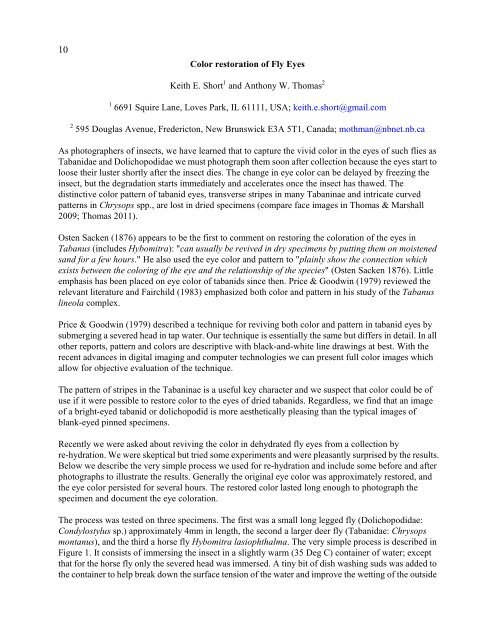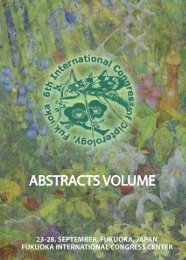Fly Times Issue 48, April 2012 - North American Dipterists Society
Fly Times Issue 48, April 2012 - North American Dipterists Society
Fly Times Issue 48, April 2012 - North American Dipterists Society
Create successful ePaper yourself
Turn your PDF publications into a flip-book with our unique Google optimized e-Paper software.
10<br />
Color restoration of <strong>Fly</strong> Eyes<br />
Keith E. Short 1 and Anthony W. Thomas 2<br />
1 6691 Squire Lane, Loves Park, IL 61111, USA; keith.e.short@gmail.com<br />
2 595 Douglas Avenue, Fredericton, New Brunswick E3A 5T1, Canada; mothman@nbnet.nb.ca<br />
As photographers of insects, we have learned that to capture the vivid color in the eyes of such flies as<br />
Tabanidae and Dolichopodidae we must photograph them soon after collection because the eyes start to<br />
loose their luster shortly after the insect dies. The change in eye color can be delayed by freezing the<br />
insect, but the degradation starts immediately and accelerates once the insect has thawed. The<br />
distinctive color pattern of tabanid eyes, transverse stripes in many Tabaninae and intricate curved<br />
patterns in Chrysops spp., are lost in dried specimens (compare face images in Thomas & Marshall<br />
2009; Thomas 2011).<br />
Osten Sacken (1876) appears to be the first to comment on restoring the coloration of the eyes in<br />
Tabanus (includes Hybomitra): "can usually be revived in dry specimens by putting them on moistened<br />
sand for a few hours." He also used the eye color and pattern to "plainly show the connection which<br />
exists between the coloring of the eye and the relationship of the species" (Osten Sacken 1876). Little<br />
emphasis has been placed on eye color of tabanids since then. Price & Goodwin (1979) reviewed the<br />
relevant literature and Fairchild (1983) emphasized both color and pattern in his study of the Tabanus<br />
lineola complex.<br />
Price & Goodwin (1979) described a technique for reviving both color and pattern in tabanid eyes by<br />
submerging a severed head in tap water. Our technique is essentially the same but differs in detail. In all<br />
other reports, pattern and colors are descriptive with black-and-white line drawings at best. With the<br />
recent advances in digital imaging and computer technologies we can present full color images which<br />
allow for objective evaluation of the technique.<br />
The pattern of stripes in the Tabaninae is a useful key character and we suspect that color could be of<br />
use if it were possible to restore color to the eyes of dried tabanids. Regardless, we find that an image<br />
of a bright-eyed tabanid or dolichopodid is more aesthetically pleasing than the typical images of<br />
blank-eyed pinned specimens.<br />
Recently we were asked about reviving the color in dehydrated fly eyes from a collection by<br />
re-hydration. We were skeptical but tried some experiments and were pleasantly surprised by the results.<br />
Below we describe the very simple process we used for re-hydration and include some before and after<br />
photographs to illustrate the results. Generally the original eye color was approximately restored, and<br />
the eye color persisted for several hours. The restored color lasted long enough to photograph the<br />
specimen and document the eye coloration.<br />
The process was tested on three specimens. The first was a small long legged fly (Dolichopodidae:<br />
Condylostylus sp.) approximately 4mm in length, the second a larger deer fly (Tabanidae: Chrysops<br />
montanus), and the third a horse fly Hybomitra lasiophthalma. The very simple process is described in<br />
Figure 1. It consists of immersing the insect in a slightly warm (35 Deg C) container of water; except<br />
that for the horse fly only the severed head was immersed. A tiny bit of dish washing suds was added to<br />
the container to help break down the surface tension of the water and improve the wetting of the outside
















